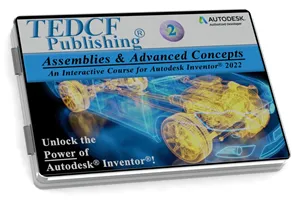Unlock the Power of Autodesk Inventor 2022!
The Inventor 2022: Assemblies and Advanced Concept course kicks your skills up to a professional level. Practice Top Down, Middle Out, and Bottom Up assembly modeling and apply advanced modeling concepts. From Model States to iPart and iFeature development and much more, this course covers advanced skills.
Learn advance skills used in Autodesk Inventor 2022. This course covers new commands like Model States and shows you additional options only advanced users use. You will practice creating advanced iPart Factories as well as custom iFeatures. Derived parts, mirrored features and parts, scaled parts … the list goes on. This course teaches advanced methods of creating parts and assemblies.
Assembly components are constrained together using constraints and joints. All the joint and constrain commands are covered in detail as well as tips and tricks used by professional modelers. You'll practice driving constraints to animate your assemblies. You'll also learn a procedure that assures you assembly constraints function the way you expect them to. The trick is to learn the details about how constraints work. This gives you the skills to take command of their use.
A mirrored assembly seems like an intuitive concept, but what about Flexible Assemblies and Derived Assemblies and parts? This course takes you step-by-step through a complete and understandable explanation of everything. You will know the details about Copied Assemblies, Mirrored Assemblies, Patterns of components and assemblies … The list to long to list here, but rest assured that each step is described in detail.
This course also shows you how to use the Design Accelerator. The Design Accelerator can be used to quickly generate assemblies containing shafts, bearings, and gears. While it's easy to use there are a few concepts you need to learn to successfully use it. This course covers all the details you need to successfully use the Design Accelerator.
Most Inventor users don't know how to create a compressible squared and ground helical compression spring. The average user can create a non-functional spring, but this course shows you how to create one that actually compresses when you animate the assembly. The skills required to do this can be extended to other assemblies and components, and this is just one example of the advanced nature of the skills taught in this course. All of these concepts are taught in an easy to understand way to assure you can leverage the power of these advanced concepts.
Presentations are used to create exploded views of your assemblies. They're typically used in assembly drawings, but you can also animate them to help show assembly workers how to assemble the product. So we show you all the details about creating and using professionally built Presentations.
iFeature design can be a tricky concept if you don't know the details about how they work. After you watch this course you'll know how they work and how to leverage their use. Excel worksheets can be used to drive them. So an iFeature easily be converted into an iFeature factory capable of creating multiple features. An example of this is a tapered pipe thread. You'll learn how to create a female pipe thread iFeature that can be used to generate any size. With a click of a button you can add tapered pipe threads cut to standard specifications. Again, this concept can be expanded to any feature you typically use.
The newest command in Inventor's arsenal of commands is Model States. An example of a Model State is a cast part that is machined to produce a final component or product. First it's cast, and then it's machined. With Model States you can create both the cast and machined versions in a single part file. So you'll have a Cast Model State and a Machined Model State in one part file. The advantages of creating such a file speak for itself, but it also adds a new level of complexity. This course shows you what you need to know to leverage the power of Model State without creating a lot of extra work.
Model states can also be applied to assemblies. Let's say your cast part can be machined several different ways to create different parts. One assembly file can be used to show all the different assemblies that can be created with each machined version. In fact, each assembly Model state can contain different components. So the assembly becomes more complex requiring a more structured procedure. This course shows you how it's done.
Did you know you can create an assembly from a 2 dimensional sketch? If you're familiar with kinematics you know it's used to develop the functional and mechanical aspect of linked components. This is typically done on a 2 dimensional sketch to simplify the development process. Once complete the 2 dimensional sketch is used to create 3 dimensional components. This course shows each step of the whole process. It briefly describes what kinematics is and then shows you how to produce a fully functional assembly.
Bottom Up design is the opposite of the kinematic design process. Each component is developed in its own part file. Once the components are in a rough draft state they are assembled in an assembly file. The next step(s) is an iterative process of editing components and the assembly to develop the final product. While this is the most time consuming method it is the most used by the average user.
A more advanced method of developing assemblies is a hybrid of the kinematic process and Bottom Up Design. The entire 3 dimensional assembly is developed in a single part file. This method is called Top Down Design. The benefit of using this method is you can simplify the development process by working with 2 dimensional sketches. Sketches can describe a portion or all of the assembly and they can be used to produce 3 dimensional components.
You may not need to learn these advanced concepts, but seeing them in practice will help you better understand the software. Inventor is simply a tool to help you get your work done. Knowing the extent of this tool will help your productivity regardless of how you use it.
The Autodesk Inventor 2022: Assemblies and Advanced Concepts course is a must see. You will learn all you'll need to know create bulletproof models and assemblies.
122 Lessons (Listed Below)
11.9 hours of instruction
You can also browse through the lessons from the following Inventor 2022 courses and watch sample lessons.
Inventor 2022: Solid Modeling Inventor 2022: Assemblies and Advanced Concepts Inventor 2022: 2D Drafting and Customization Inventor 2022: Sheet Metal Design Inventor 2022: Tube and Pipe Routed Systems Inventor 2022: Inventor Studio Made Simple Inventor 2022: iLogic Made Simple Inventor 2022: Fea Made Simple Inventor 2022: Dynamic Simulation Made SimpleOur Inventor courses require No Installation. You can watch them on any device connected to the internet.
You will receive an email containing your User Name and Password. Login to your account and start learning. It's that easy.
While you're logged into your account you can download files used in the courses, watch lessons, and practice the tasks taught in the lessons. Keep in mind that you will use your installation of Inventor to practice.
Get your Inventor 2022 training now. You can start learning in minutes.
Autodesk Inventor® 2022:
Assemblies and Advanced Concepts
No Installation Required
Watch from any device connected to the internet.

$59.95 - $229.95
Watch Sample Lessons
Watch the first hour of the Solid Modeling course for Autodesk Inventor 2022.
 Click to Watch!
Click to Watch!Assemblies and Advanced Concept
11.9 hours of instruction
Lessons
Introduction
Sketch Origin Node
Using and Creating Templates
Creating Derived Parts
Editing Derived Parts
Intro to the Assy Environment
Degrees of Freedom
Driving Constraints
Explicit Reference Vectors
Adaptive Parts and Sketches
Adaptive Constraint Strategies
Creating Adaptive Parts I
Creating Adaptive Parts II
Using Constraint Strategies
Removing Adaptivity
Driving Adaptive Assemblies
The Content Center
The Symmetry Constraint
Ball Joints
Planar Joints
Joint Alignment Details
Cylindrical Joints
Slider Joints
Rotational Joints
Rigid and Automatic Joints
Mirrored Assemblies
Mirrored and Copied Constraints
Flexible Assemblies
Copied Assemblies
Pattern Components
Advanced Viewing
Assembly Viewing
Motion Constraints
Animating Gears Motion
Animating Gears Contact Set
Transitional Constraints
Collision Detection
Contact Solver
Checking for Interferences
Creating Compressible Springs
Driving Adaptive Springs
Positional Representations
Creating Presentations
Editing Tweaks
Working with Storyboards
Presentation Opacity
Presentation Camera Settings
Animating Presentations
Presentation Snapshot Views
No Storyboard Exploded Views
iFeature Design
Inserting iFeatures
Reusing Part Features
Advanced iFeature Design
Reducing Dangling Geometry
Creating iPart Factories
iPart Members
Editing the iPart Author
iMates and iParts
Custom iParts
Creating iPart Assemblies
Updating iParts
Threaded iParts
iMates and the Content Center
Identifying and Using iMate Glyphs
Inferred iMates
Scaling Parts
Combining Parts I
Combining Parts II
Subtracting and Splitting Parts
Deleting Faces
Strategy for Splitting Parts
Trick for Measuring Interferences
Prep for Design Accelerator
Bolted Connections
Generating Bearings
Generating Shafts Part I
Generating Shafts Part II
Generating Shafts Part III
Generating Gears
Generating Keyways
Advanced Spring Design I
Advanced Spring Design II
Animating Springs
Preparing for Model States
Defining Model States
Advanced Arrays
Working with Model States
Fixing Model States
Model State iProperties
Assembly Model States
Saving Under Part Number
Saving Under Assembly Number
Working with Large Assemblies
Adaptive vs Positional Rep
Using Design Views
Introduction to Simplify
Simplify Properties Settings
Presets Envelops and Includes
Modifying and Deleting Presets
Skeletal Modeling Introduction
Make Part and Components
Kinematics
Sketch Blocks
Advanced Top Down Design
Blocks and Assemblies
Modeling Techniques I
Modeling Techniques II
Flexible Block Assemblies
Hybrid Design Methods
Alternate Slice Method
Import Assy to Part File
Middle Out Design
Exporting Bodies to an Assembly
Replacing Assemblies
Sinusoidal Conical Sweeps
Alternate Split Part Methods
Appearances on Derived Features
Selecting a Design Strategy
Practice with Relationships
Inverted Text
Conclusion
